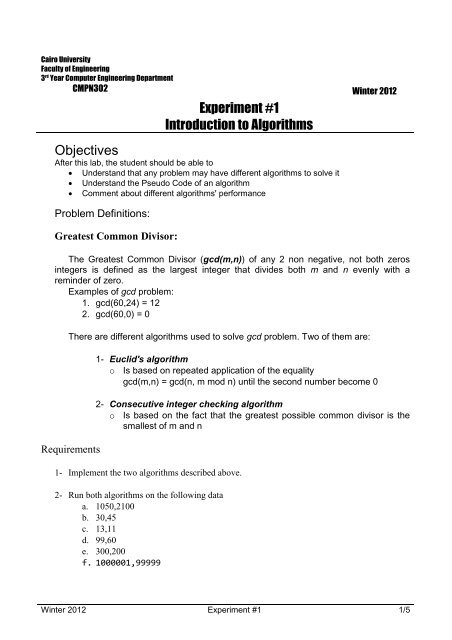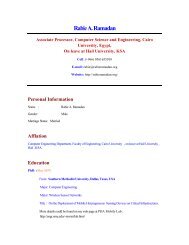Objectives Experiment #1 Introduction to Algorithms
Lab 1 - Rabie Ramadan
Lab 1 - Rabie Ramadan
Create successful ePaper yourself
Turn your PDF publications into a flip-book with our unique Google optimized e-Paper software.
Cairo University<br />
Faculty of Engineering<br />
3 rd Year Computer Engineering Department<br />
CMPN302 Winter 2012<br />
<strong>Objectives</strong><br />
<strong>Experiment</strong> <strong>#1</strong><br />
<strong>Introduction</strong> <strong>to</strong> <strong>Algorithms</strong><br />
After this lab, the student should be able <strong>to</strong><br />
Understand that any problem may have different algorithms <strong>to</strong> solve it<br />
Understand the Pseudo Code of an algorithm<br />
Comment about different algorithms' performance<br />
Problem Definitions:<br />
Greatest Common Divisor:<br />
The Greatest Common Divisor (gcd(m,n)) of any 2 non negative, not both zeros<br />
integers is defined as the largest integer that divides both m and n evenly with a<br />
reminder of zero.<br />
Examples of gcd problem:<br />
1. gcd(60,24) = 12<br />
2. gcd(60,0) = 0<br />
There are different algorithms used <strong>to</strong> solve gcd problem. Two of them are:<br />
Requirements<br />
1- Euclid's algorithm<br />
o Is based on repeated application of the equality<br />
gcd(m,n) = gcd(n, m mod n) until the second number become 0<br />
2- Consecutive integer checking algorithm<br />
o Is based on the fact that the greatest possible common divisor is the<br />
smallest of m and n<br />
1- Implement the two algorithms described above.<br />
2- Run both algorithms on the following data<br />
a. 1050,2100<br />
b. 30,45<br />
c. 13,11<br />
d. 99,60<br />
e. 300,200<br />
f. 1000001,99999<br />
Winter 2012 <strong>Experiment</strong> <strong>#1</strong> 1/5
3- For the previous data fill the following table.<br />
input Euclid Brute Force<br />
# of iterations # of iterations<br />
1050,2100<br />
30,45<br />
13,11<br />
99,60<br />
300,200<br />
1000001,99999<br />
Winter 2012 <strong>Experiment</strong> <strong>#1</strong> 2/5
Prime Numbers:<br />
A prime number (or a prime) is a natural number greater than 1 that has no positive divisors<br />
other than 1 and itself. One of the most common problems is finding the Prime numbers in a<br />
certain range, this can be done using:<br />
1. Brute Force algorithm:<br />
By testing all numbers one by one.<br />
2. Sieve of Era<strong>to</strong>sthenes<br />
Algorithm:<br />
To find all the prime numbers less than or equal <strong>to</strong> a given integer n by Sieve method:<br />
Requirements<br />
1. Create a list of consecutive integers from 2 <strong>to</strong> n: (2, 3, 4, ..., n).<br />
2. Initially, let p equal 2, the first prime number.<br />
3. Starting from p, count up in increments of p and mark each of these numbers greater<br />
than p itself in the list. These numbers will be 2p, 3p, 4p, etc.; note that some of them<br />
may have already been marked.<br />
4. Find the first number greater than p in the list that is not marked.If there was no such<br />
number, s<strong>to</strong>p. Otherwise, let p now equal this number (which is the next prime), and<br />
repeat from step 3.<br />
When the algorithm terminates, all the numbers in the list that are not marked are<br />
prime.<br />
1- Implement the two algorithms described above.<br />
2- Run both algorithms on the following data<br />
a. 100<br />
b. 1000<br />
c. 10000<br />
d. 100000<br />
e. 200000<br />
3- For the previous data fill the following table.<br />
input Brute Force Sieve<br />
Time in MS Time in MS<br />
100<br />
1000<br />
10000<br />
100000<br />
200000<br />
Winter 2012 <strong>Experiment</strong> <strong>#1</strong> 3/5
AnotherFibonacci<br />
AnotherFibonacci sequence begins by defining the first three elements A[0], A[1]<br />
and A[2]. The remaining elements are calculated using the following recurrence:<br />
A[i] = A[i-1] + A[i-2] + A[i-3]<br />
You are given a int[] A which contains exactly one element that is equal <strong>to</strong> -1, you must<br />
replace this element with a positive number in a way that the sequence becomes a<br />
AnotherFibonacci sequence. Return this number.<br />
If no such positive number exists, return -1.<br />
It’s required that you implement and test this following class by the example data, and write the<br />
complexity of your algorithm if you can (in terms of time, iterations, or number of basic operations)<br />
Definition<br />
Class: AnotherFibonacci<br />
Method:<br />
complete<br />
Parameters: array of integers<br />
Returns:<br />
int<br />
Method signature (in C#): int complete(int[] A)<br />
Notes<br />
- The constraints for the elements of the input int[] A do not necessarily apply for the<br />
replacement <strong>to</strong> the missing element.<br />
Constraints<br />
- A will contain between 4 and 20 elements, inclusive.<br />
- Each element of A will be -1 or between 1 and 1000000, inclusive.<br />
- Exactly one element of A will be -1.<br />
Examples<br />
0)<br />
input = {1,2,3,-1}<br />
Returns: 6<br />
Winter 2012 <strong>Experiment</strong> <strong>#1</strong> 4/5
1)<br />
input = {10, 20, 30, 60, -1 , 200}<br />
Returns: 110<br />
2)<br />
input = {1, 2, 3, 5, -1}<br />
Returns: -1<br />
No replacement can make this sequence AnotherFibonacci as 5 is not equal <strong>to</strong> 1+2+3.<br />
3)<br />
{1, 1, -1, 2, 3}<br />
Returns: -1<br />
The missing element must be 0 for this sequence <strong>to</strong> be AnotherFibonacci. Since this is not a positive<br />
integer, return -1.<br />
4)<br />
{-1, 7, 8, 1000000}<br />
Returns: 999985<br />
Winter 2012 <strong>Experiment</strong> <strong>#1</strong> 5/5



